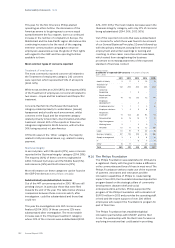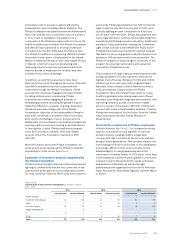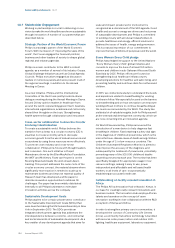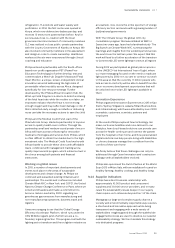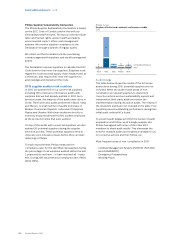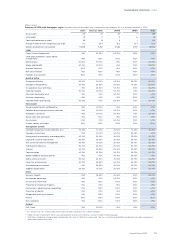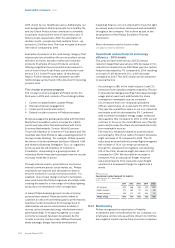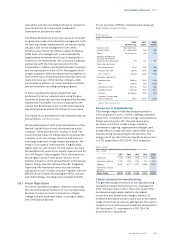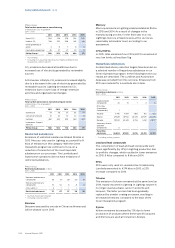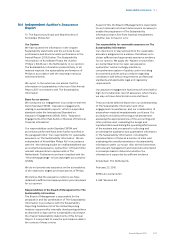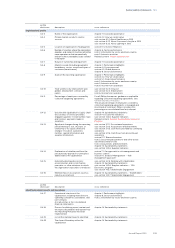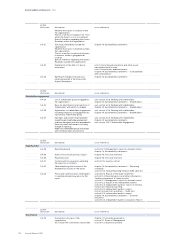Philips 2015 Annual Report Download - page 201
Download and view the complete annual report
Please find page 201 of the 2015 Philips annual report below. You can navigate through the pages in the report by either clicking on the pages listed below, or by using the keyword search tool below to find specific information within the annual report.
Sustainability statements 14.2.8
Annual Report 2015 201
transition towards a Circular Economy by implementing
circular procurement within purchasing processes,
policies and strategy by the end of 2016.
Philips is currently involved in over 20 Circular Economy
projects and most of them involve procurement.
Circular Economy (Value Leakage model) is now part of
the DfX training (Design for X), which is a program and
toolbox for proactively including end-user experience
in the product development phase. As such, 90% of our
procurement colleagues have been trained in this
concept so far. The rst Circular Economy DfX
convention was held in 2015, focusing on refurbishing
returned garment care steam generators.
More successful applications of circular procurement
can be found in non-product-related procurement
such as services or equipment. In 2015, we continued in
our successful partnership with HP to create a secure
and compliant global process for the disposal of retired
IT hardware.
HP Case Study
Over the past years the Philips-HP relationship
has managed over 60,000 assets across 22
countries spanning 4 continents. the process has
been covering activities from data wiping, which
comprehensively mitigates security and privacy
risks, through to remarketing and recycling.
Notwithstanding the signicant volume of assets,
coming from so many locations, the HP Asset
Recovery service has been able to remarket 90%
of them, ensuring that even after their useful life
within the Philips business has ended, these
assets can return value as part of a well-structured
end-of-life asset management process. For the
remaining 10% of products, HP provides a full
recycling service that recovers valuable raw
materials and ensures compliance with our zero
landll policy.
“Philips stands out as an organization that truly
understands the importance of managing their
legacy IT, both from a perspective of recognizing the
maximum value of their IT Assets but also and
arguably more importantly, recognizing their
corporate social responsibility to ensure they
manage their disposal process with minimal
environmental impact. It’s for this reason that HP is
proud to be Philips partner of choice for Asset
Recovery Services and will continue to collaborate
on our shared circular economy objectives.”
Dr. Kirstie McIntyre
HP Social and Environmental Responsibility Director,
EMEA
Process chemicals
Process chemicals are and will remain a topic of high
concern for Philips and as such we will continue
addressing it through industry collaboration (EICC
taskforce) as well as via the new Philips approach to
supplier assessment and capacity building which will
be launched in 2016.
In our new supplier sustainability approach we aim to
structurally improve the sustainability performance at
our suppliers. Within this new approach, one of the key
areas to address is Health & Safety at our supplier sites.
Philips will focus on training suppliers to manage
process chemicals, from integration into management
systems, information sharing, handling and protective
measures, to their reduction and full elimination.
The EICC taskforce on process chemicals in the supply
chain initiated by Philips in 2014 focuses on high-risk
production processes. The taskforce is working towards
one industry approach with the nal goal of eliminating
hazardous process chemicals, or – if no alternatives are
available – minimizing the health risks for workers
handling these chemicals. We are continuing an active
multi-stakeholder engagement dialogue and working
towards dening one list of ‘process chemicals of
concern’ that can be used across dierent industries,
including a plan for substitution or elimination.
Chemical management is a critical component of the
EICC Code of Conduct, as reected in Section B –
Health and Safety, and Section C – Environment. These
two sections have been a point of emphasis in the EICC
Validated Audit Process auditor training in 2015.
Chemical management is also a point of emphasis in
the EICC training programs, with course oerings in four
categories.
14.3 Environmental statements
This section provides additional information on (some
of) the environmental performance parameters
reported in section 5.3, Environmental performance, of
this Annual Report.
14.3.1 EcoVision
Our latest EcoVision program includes key performance
indicators in relation to Green Product sales, Improving
people’s lives, Green Innovation, Green Operations,
Health & Safety, Employee Engagement and Supplier
Sustainability and ended in 2015. We plan to announce
our next ve-year sustainability program in the second
quarter of 2016.
Improving people’s lives
At Philips, we strive to make the world healthier and
more sustainable through innovation. Our goal is to
improve the lives of 3 billion people a year by 2025.
Through Philips products and solutions that directly
support the curative or preventive side of people’s
health, we improved the lives of 881 million people in



